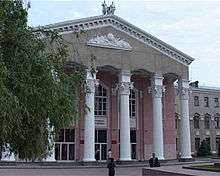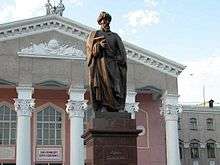Kyrgyz National University


Kyrgyz National University named after Jusup Balasagyn (Kyrgyz: Жусуп Баласагын атындагы Кыргыз Улуттук Университети) is a national university of Kyrgyzstan located in the capital city of Bishkek; is state higher educational institution of the Kyrgyz Republic, the oldest and the largest higher educational institution of the republic. Educational institution was established on October 25, 1925 as the Kyrgyz Institute of Education.
Kyrgyz National University is named after Yusuf Balasaghuni (Kyrgyz: Жусуп Баласагын).
History
October 25, 1925, it was decided to open the Institute of Education. This was to solve the problems in the training of pedagogical personnel on the territory of the Republic. The training period was 7 years.
In 1928, by the decision of the government of the Kirghiz Autonomous Soviet Socialist Republic the Institute of Education was transformed into the Kirghiz Central Pedagogical Technical School. In August 1929, they began to build new buildings, invited specialists and teachers from other USSR republics and brought equipment.
January 13, 1932, by the decision of the Council of People's Commissars of the USSR, it was transformed into the Kyrgyz State Pedagogical Institute named after Frunze. There were 4 faculties in the institute: physics and mathematics, biology, literature and the faculty of social sciences. The first academic year began on October 3, 1933.
May 21, 1951 by the decree of the Council of Ministers of the USSR it was transformed into the Kyrgyz State University, with the following faculties: philology, biology, physics, mathematics, history, geology and geodesy. In the decree adopted by the Council of Ministers, the Kyrgyz State University belonged to higher educational institutions of the first category.
December 11, 1972 was renamed into the Kyrgyz State University of 50th anniversary of the USSR.
By the Decree of the President of the Kyrgyz Republic of August 11, 1993, it was transformed into the Kyrgyz State National University (KGNU).
By the Decree of the President of the Kyrgyz Republic on May 11, 2002 was renamed into the Kyrgyz National University named after Zhusup Balasagyn.
May 31 - the day of the establishment of the Kyrgyz Institute of Education - is an annual celebration of the University.
Awards
In 1982, the university was awarded the Soviet Union's Order of the Red Banner of Labor.[1]
University structure
There is Academical Worker's Union Committee , which defends the professional interests of educators.
The supervisory function in the KNU is performed by the Board of Trustees, which includes prominent public figures, scientists and graduates. In total there are 8 members in the Board of Trustees.
The highest collegiate management body in the KNU is the Scientific Council, in which there are 63 members.
Kyrgyz National University named after Zhusup Balasagyn includes the following structures:
Faculties
- Faculty of State and Municipal Management.
- Faculty of Mathematics, Computer Science and Cybernetics.
- Faculty of Physics and Electronics.
- Faculty of Information and Innovation Technologies.
- Faculty of Chemistry and Chemical Technology.
- Faculty of Biology.
- Faculty of Geography and Ecology and Tourism.
- Faculty of Kyrgyz Philology.
- Faculty of Russian and Slavic philology.
- Faculty of History and Regional Studies.
- Faculty of Journalism.
- Faculty of Social and Human Sciences.
- Faculty of Foreign Languages.
- Kyrgyz - European Faculty.
- Faculty of International Relations and Oriental Studies.
- Kyrgyz - Chinese Faculty.
- Pedagogical Faculty.
- Faculty of Retraining and staff development.
- Faculty of State and Municipal Management.
- Faculty of Economics.
- Faculty of Law.
- Faculty of Management and business.
Institutions
- Kyrgyz-Chinese Confucius Institute.
- Institute of Basic Sciences.
Colleges
- Professional - pedagogical college.
- Juridical College.
- College of Economics.
- Kyrgyz - Chinese College.
- IT College.
Centers, departments, departments and sectors
- The Korean Center.
- Turkish Language Center.
- Turkish Resource Center named after Aziz Sanzhar.[2]
- The Japanese Center.
- Department of International Cooperation.
- Press.
- Center for Language Studies.
- General department.
- Archive.
- Sector for Civil Defense and Special mobilization Work.
- Department of legal work.
- Human Resources Department.
- Educational-methodical management.
- Department of Informatization and Coordination of Academic Work.
- Sector of licensing, accreditation and methodical work.
- Dispatching service.
- Department for the preparation and issuance of documents on education.
- Department of postgraduate study, doctoral studies and magistracy.
- Scientific library named after A.Tabaldiev.
- Department of Information Technology and Computer Maintenance.
- State language Department.
- Educational work Department.
- Practice and employment Sector.
- Scientific-Research Center "Atmosphere Monitoring".
- Youth Committee.
- Council of Young Scientists.
- Alumni Association.
Economic management
The economic management of the KNU is carried out by the pro-rector for administrative and economic work. Management consists of the following structures:
- Planning and Finance Department.
- Accounting.
- Department for the operation of buildings and structures.
- Industrial and technical sector.
- Sector for material procurement of public procurement.
- Sector for occupational safety and health.
- Sports services sector.
- Service plumbers, electricians, carpenters, automatic telephone station.
- Security service.
- Transportation Department.
- Botanical garden and landscaping of the KNU territory.
- Boarding house "University".
- Printing house.
- "Azamat".
- The designer.
Affiliates
There is a campus in Osh city, Kyrgyzstan (Economic and Pedagogical Faculty).
Chairs
The National Gymnasium of the KNU and the Department of Physical Culture of Sports are operating in the KNU. In total there are 61 academical departments in KNU at 19 faculties.
Editorial Publishing Department ("Vestnik KNU" - magazine)
.jpg)
The magazine "Vestnik of the Kyrgyz National University named after Zhusup Balasagyn" has been published since 1997. It is a scientific-educational, information publication of the KNU. The journal is registered by the Ministry of Justice of the Kyrgyz Republic (Certificate of Registration No. 1530, May 15, 2009).
The magazine is included in the list of leading peer-reviewed scientific journals and publications recommended by the Higher Attestation Commission of the Kyrgyz Republic.
The scientific-educational and informational magazine is intended for publication of the main results of dissertations for obtaining the scientific degrees of ini sciences in the field of natural and technical, humanities and social sciences, education and pedagogy, IT and innovative technologies, problems of history and the current state of higher education The Kyrgyz Republic, including KNU. The journal highlights the theory and practice of modernization of domestic and foreign higher education.
The license agreement on the inclusion of the magazine in the list of publications the system of the Russian Science Citation Index (RSCI) was signed on March 1, 2016 No. 03-01 / 2016.
In total, 5 issues were published in 2016. Of these, 4 issues were planned, 1 issue was a special issue. All articles of issues for 2016 entered the RSCI, which is confirmed on the website of the RSCI. There is no statistics on citation.
The head of the department and the editor-in-chief of the journal is Mr.Chotonov, PhD, professor.
Foreign members of the editorial and publishing council:
- Mr.Borodkin - Dr. Science., Professor of Moscow State University named after Lomonosov, corresponding member of the Russian Academy of Natural Sciences.
- Mr.Akhunbaev - Head of the Research Section of the Eurasian Development Bank, Doctor, Professor.
- Mr.Peregudin - PhD, Professor at St.Petersburg State University.
Educational process in KNU
The educational process in KNU takes place in the following directions:
- Undergraduate: on campus and in absentia; 56 programs.
- Five year study: on campus and in absentia; five programs.
- Magistracy: on campus and in absentia; 32 programs.
- Secondary vocational education: on campus and in absentia; 14 programs.
- At the Faculty of Economics and Pedagogy in the city of Osh - in absentia; 10 programs.
The educational process follows the Bologna Process.
KNU Rectors
Below is a list of rectors of KNU.
- 1951-1954 - B. Zhamgyrchinov
- 1954-1960 - B. Yunusaliev
- 1960-1977 - S. Tabyshaliev
- 1977-1979 - M. Imanaliev
- 1979-1986 - K. Otorbaev
- 1986-1992 - U. Asanov
- 1992-1998 - S. Toktomyshev
- 1998-2000 - A. Borubayev
- 2000-2005 - A. Kakeev
- 2005-2006 - I. Bolzhurova (Acting)
- 2006-2008 - Y. Omurkanov
- 2008-2009 - A. Bekbalaev
- 2009-2010 -
- 2010-2011 - A. Akunov
- 2011-2014 - I. Isamidinov
- 2015-2017 - C. Adamkulova
Educators
As of 2016-2017 academic year, the teaching staff of the KNU is 2,654 people. Of them with a scientific degree: 1,908 people, representing 71.9% of the total number of full-time teachers. Also, there are 271 people working in the KNU. Of them with a scientific degree: 183 people, which is 67.5% of the total number of teachers on a part-time basis. A total of 2837 people work in the KNU, of which 2,091 people (73.7%) have a scientific degree, including 103 people holding a Ph.D., 469 candidates of doctors of sciences, 67 professors, 339 associate professors.
Famous Alumni
- Shabdanbai Abdyramanov - People's writer of Kyrgyzstan.
- Kazat Akmatov - People's Writer of Kirghizia.
- Mar Baidzhiyev (born 1935) is a people's writer of Kirghizia.
- Aron Brudny - Kirghiz scientist, psychologist and philosopher.
- Medi Mamazairova - Kirghiz poet, Honored Worker of Culture of Kyrgyzstan.
- Vladimir Ploski - Kirghiz scientist
- Shatman Sadybakasov - Kyrgyz journalist, editor.
- Vyacheslav Shapovalov - National poet of Kirghizia
- Ozgorush Sharshekeev - Kyrgyz scientist
- Mukhamed Tsikanov - Russian statesman.
Library
The KNU Scientific Library is one of the largest university libraries in the system of higher education in Kyrgyzstan. The book fund includes scientific, educational and fiction books, books in Kyrgyz and Russian languages in all fields of knowledge, foreign literature, periodicals and continuing editions, works, scholarly notes, Ph.D. and doctoral dissertations, abstracts, encyclopaedic and reference publications.
The scientific library was established in 1932 on the basis of the Kyrgyz Pedagogical Institute. In 1941, the library's book stock was 134 thousand copies, obtained from the universities of Moscow, Leningrad and other major cities of the USSR. In 1951 the KNU library received educational, scientific and artistic literature from Odessa, Kiev, Kharkov, Kazakh and Tomsk universities, as well as from the Academies of Sciences of Armenia, Georgia, Uzbekistan and Ukraine.
The library is located in 8 educational buildings and has 60 employees.
References
- ↑ "Istoriya KNU". 15 September 2012. Retrieved 3 October 2014.
- ↑ Жээнбек, Эралиев. "Кыргызский национальный университет имени Жусупа Баласагына". www.knu.kg (in Russian). Retrieved 2017-08-01.
External links
| Kyrgyz National University | |
|
|